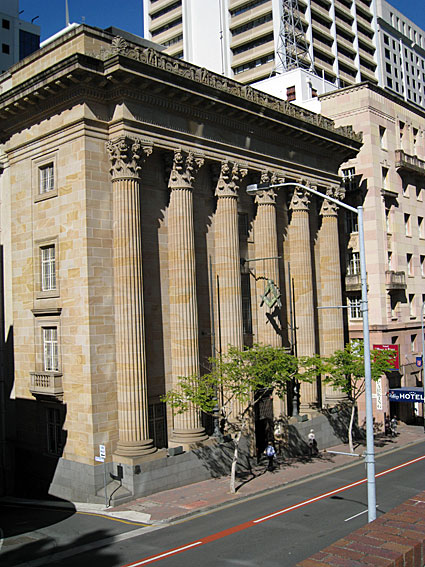
The Masonic Temple, Brisbane
[Photograph by Geoffrey Cox (July 2011)]

The Masonic Temple, Brisbane
[Photograph by Geoffrey Cox (July 2011)]
Historical and Technical Documentation by Geoffrey Cox
© OHTA 2007, 2001, 2018 (last updated June 2018)
Freemasonry in Queensland dates from the 1850s, and the United Grand Lodge of Queensland was formed on 27 April 1921 by the union of the 281 Freemason's lodges in Queensland. To commemorate this event, a competition was held for the design of a centrally located temple. The winning design by the architect, Lange L. Powell, was in Classical Revival style. The façade is dominated by massive sandstone Corinthian columns on a granite base, surmounted by a deep entablature and pediment. The building was opened on Wednesday 10 December 1930.1
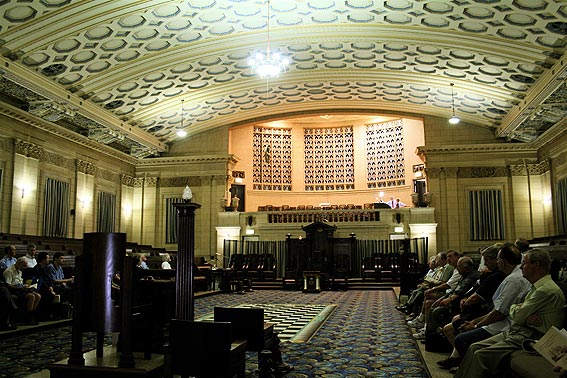
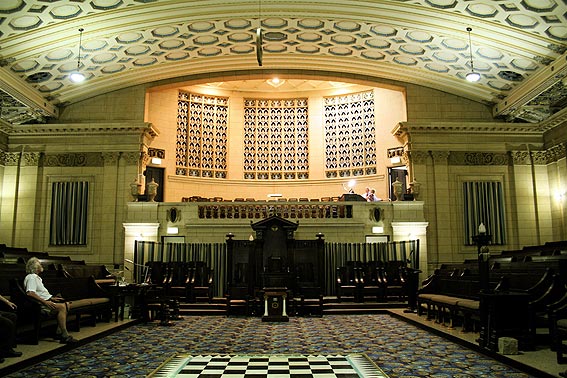
[Photographs by Trevor Bunning (October 2007)]
The organ in the Grand Hall, situated on the top floor of the building, was built by Whitehouse Bros of Brisbane at a cost of £1,717.2 The contract for the organ had been negotiated from at least September 1929.3 It was completed in time for the opening and dedication of the building in December 1930. A newspaper report described the music for the occasion as follows:
The service in the Great Hall was fully choral, and the mellow tones of the grand organ, combined with the splendid work of the choir, filled the hall with a paean of praise that was impressive in its majesty.4
The organ is placed in a purpose-built chamber, with the pipework hidden from the body of the hall by an ornamental grille.

Ornamental grille
[Photograph by Howard Baker (1990s)]
This instrument was among the larger tubular pneumatic organs built by the Whitehouse firm in Queensland. The stop tabs were originally of the 'inclined-block' type, placed in a row above the upper manual. The specification, of 20 stops over two manuals and pedals, was slightly larger than those at St Mary's, Ipswich (1915; 19 stops) and St Brigid's, Red Hill (1914; 17 stops). The differences in tonal design from the earlier instruments are clear: As at West End Methodist Church (1924; 19 stops), The Southport School (1924-25; 23 stops), St Paul's Presbyterian Church, Armidale, NSW (1929; 16 stops), Inverell Methodist Church, NSW (1929; 15 stops) and Chatswood Methodist Church, Sydney (1930; 17 stops), there was a general shift towards more foundation tone, now with nothing above 4ft stops on either the Swell or the Great. As at West End, Southport, Chatswood and Inverell, the 16ft manual flue stop now appears on the Great rather than on the Swell:
| GREAT Bourdon Open Diapason Dulciana Salicional Flute Amabile Principal Flute Trumpet SWELL Violin Diapason Lieblich Gedact Echo Gamba Voix Celeste Geigen Principal Cornopean Oboe Vox Humana PEDAL Bourdon Echo Bourdon Violoncello Bass Flute COUPLERS Swell to Pedal Great to Pedal Swell to Great Swell to Great Super Swell to Great Sub Swell Super Octave Swell Sub Octave |
16 8 8 8 8 4 4 8 8 8 8 8 4 8 8 8 16 16 8 8 |
A B A B |
Detached Stop-key console
3 combination pistons to Great Organ
3 combination pistons to Swell Organ
Full-organ piston
Radiating concave pedalboard
Balanced swell pedal
Swell tremulant
Compass: 61/30
Pneumatic action.5
The console was moved by Whitehouse Bros in 1936, and a new roll-top console was supplied in 1952,6 placed to one side of the choir rather than in the centre.
The action of the organ was electrified in 1985-86 by H.W.Jarrott, who also added a Flautino 2ft stop to the Swell Organ in place of the original Vox Humana 8ft in 1987.7 The Vox Humana pipes were placed in storage on top of the Swell Box.8 An additional coupler (Great Octave) was also supplied, along with toe pistons for the Pedal Organ, and other accessories.9 Console fittings and stop nomenclature were also altered at this time (see below).
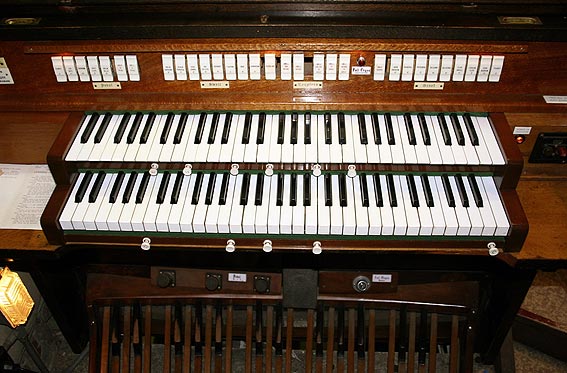

The 1952 Whitehouse console, modified by H.W. Jarrott in 1985-86
[Photographs by Trevor Bunning (October 2007)]
In 2000-01, further renovation was undertaken by W.J. Simon Pierce, who restored the wind pressure to its original level and added a Fifteenth 2ft to the Great Organ in the original position of the Trumpet stop. The Trumpet was placed on a new separate chest, and made available on both the Great and the Pedal. The Pedal Bourdon (originally named 'Echo Bourdon') was increased in scale with the addition of a new bottom C pipe. The organ became known on 6 September 2000 as 'The John Broughton Organ' in honour of the contribution of Mr John Broughton as Grand Organist over twenty-five years from 1975 to 2000.10
Minor damage was caused in February 2018, when the organ chamber was invaded by a former Freemason, naked and in a state of inebriation. He was armed with a toy gun, a remote-controlled police car and seven McDonald's cheesebergers which he intended to distribute to the homeless. The damage was limited to some Pedal Bourdon pipes, some bent and twisted Great pipes, a wind trunk, and Vox Humana pipes thrown at the police through the ornamental grille!11
There are proposals for further additions, but the specification and nomenclature are currently as follows:
| GREAT Echo Bourdon 16 A Open Diapason 8 Dulciana 8 Salicional 8 Flute Amibile 8 Principal 4 Lieblich Flute 4 Fifteenth 2 Trumpet 8 C SWELL Violin Diapason 8 B Echo Gamba 8 Vox Celeste 8 Gedackt 8 Geigen Principal 4 Flautino 2 Cornopean 8 Oboe 8 PEDAL Sub Bass 16 Bourdon 16 A Violincello 8 B Bass Flute 8 Trumpet 8 C COUPLERS Swell to Pedal Great to Pedal Swell to Great Great Octave Swell Octave Swell Sub Octave Swell Octave to Great Swell Sub Octave to Great |
16 8 8 8 8 4 4 2 8 8 8 8 8 4 2 8 8 16 16 8 8 8 |
A C B A B C |
[2001] [1987] [formerly 'Bourdon'] [formerly 'Echo Bourdon'] [2001] [c.1987] |
Detached console (rocking-tablet stops)
3 combination pistons to Great Organ
4 combination pistons to Swell Organ
3 toe pistons to Pedal Organ
Full-organ toe piston
General Cancel thumb piston
Radiating concave pedalboard
Balanced swell pedal
Swell tremulant
Compass: 61/30
Electro-pneumatic action.12
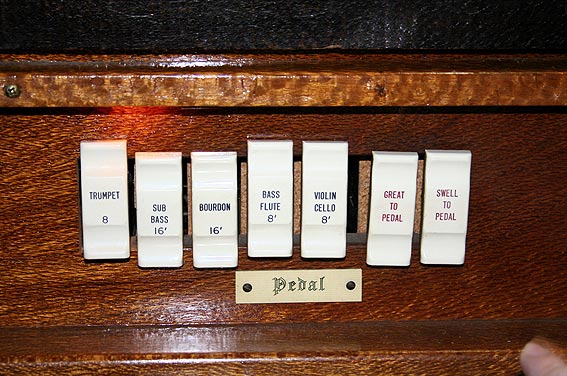
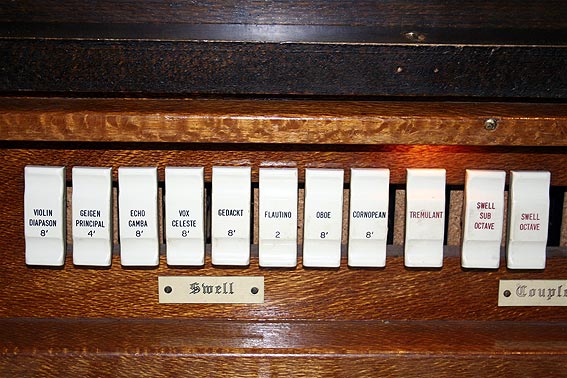

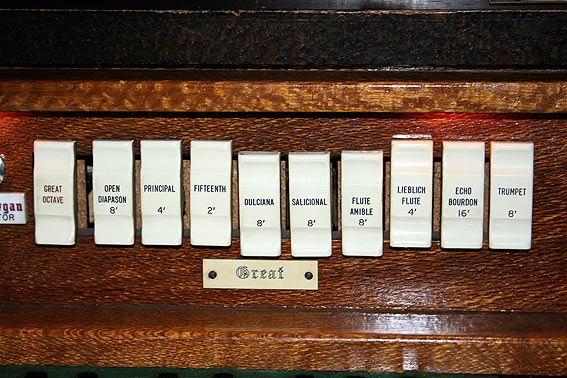
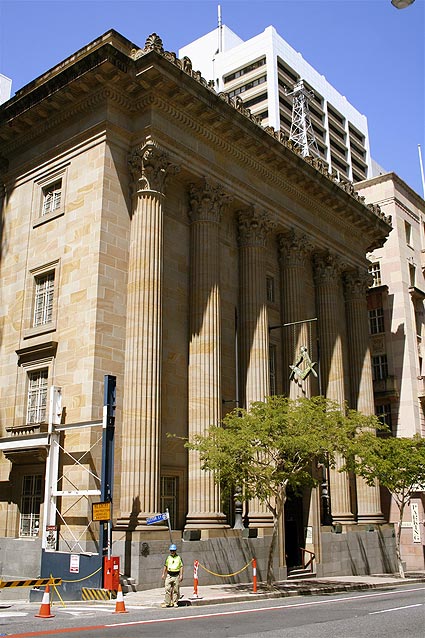
[Photographs by Trevor Bunning (October 2007)]
_________________________________________________________________________
1 Queensland Heritage Council, Queensland Heritage Register, location 600074; The Brisbane Courier (5 December 1930), pp. 13, 16; The Queenslander (11 December 1930), pp. 28, 42.
2 Whitehouse Bros Ledger (1922-1940), p. 490; The Church Standard (5 December 1930).
3 John Broughton, 'The Life and Times of the Pipe Organ in the Grand Hall of the Masonic Centre, Brisbane,' The Organ Voice, vol. 27, no. 2 (June 2001), p. 5.
4 The Brisbane Courier (11 December 1930), p. 18. The Whitehouse Bros list gives the date as 1931, and the ledger entry (see above) records final payements made in 1931.
5 Specification from Notebooks of Edward R. Salisbury (n.d.), and Collected Organ Specifications of Bernie Brohan (c.1952); compass and borrowing details for 'Violoncello' and 'Echo Bourdon' noted subsequently.
6 Whitehouse Bros Ledger (1922-1940), p. 490; Whitehouse Bros List.
7 Personal communication to G. Cox from H.W. Jarrott, c.1988.
8 Peter Meyer, 'Column 8ft,' The Sydney Organ Journal, vol. 49, no. 3 (Winter 2018), p. 9.
9 Broughton, p. 7.
10 Broughton, p. 8; The Organ Voice, vol. 26, no. 3 (September 2000), p. 28; The Organ Voice, vol. 27, no. 2 (June 2001), p. 31.
11 Daily Mail (22 June 2018), cited at http://www.dailymail.co.uk/news/article-5422759/Former-Freemason-naked-inside-pipe-organ-Brisbane.html; Meyer, op. cit., p. 9.
12 Specification noted by G. Cox, October 2007, with additional details supplied by W.J. Simon Pierce, March & May 2002.